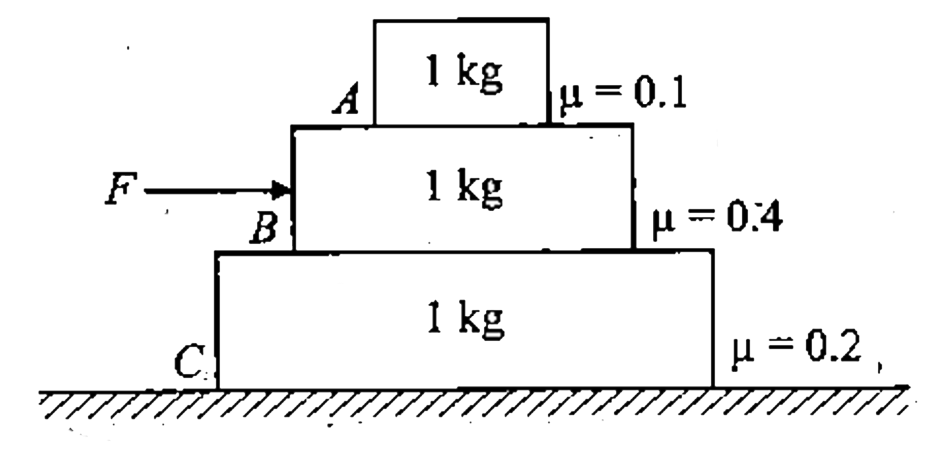In the situation shown in fig
a. What minimum force F will make any part or whole system move?
b. Find the acceleration of two blocks and value of friction at the two surface if F=6N

Between 4kg and ground:
f1t=fk1=μ1(2+4)g=6N
Between 2kg and 4kg:f12=fk2=μ22g=4N
a. Obviously sliding will occur first between 4kg and ground .Because 2kg can slide over 4kg only after 4kg gains some acceleration .
b. 4kg will start sliding on ground if
F>f1t=6NorFmin=6N
c. Maximum acceleration of 2kg block can be μ2=0.2×10=2ms−2
Both blocks can move together up to the combined acceleration of 2ms−2 . To produce the acceleration 2ms−2
F−fk1=(2+4)×2⇒F=18N
When F>18N the acceleration of 4kg will became more than 2ms−2 but that of 2kg cannot became more than 2ms−2 , Hence , sliding will occur between 2kg and 4kg forF>18N
i. F=3N system cannot move because F<ft1 , so acceleration of both blocks is zero. Friction between 4kg and ground =f1=F=3N As 2−kg blocks has no tendency to slide over 4kg friction between 2kg and 4kg blocks is zero
ii. F=12N<18N,butF<ft1 , so both the blocks will move with common acceleration .

a=F−fk12+4=12−66=1ms−2
Friction between 4kg and ground is fk1=6N
Friction between 2kgand4kg
f2=2a=2×1=2N
iii. F=24N>18N here slipping will occut at both the contact surface Hence friction between 4kg and ground 2kgand4kg will be fk1=4N
Acceleration of 4kg
a1=24−6−44=3.5ms−2
Acceleration of 2kg blocks a2=fk12=42=2ms−2

Topper's Solved these Questions
- NEWTON'S LAWS OF MOTION 2BOOK - CENGAGE PHYSICSCHAPTER - NEWTON'S LAWS OF MOTION 2EXERCISE - Solved Examples
12 Videos
- NEWTON'S LAWS OF MOTION 2BOOK - CENGAGE PHYSICSCHAPTER - NEWTON'S LAWS OF MOTION 2EXERCISE - Exercise 7.1
25 Videos
- NEWTON'S LAWS OF MOTION 1BOOK - CENGAGE PHYSICSCHAPTER - NEWTON'S LAWS OF MOTION 1EXERCISE - Integer
5 Videos
- PROPERTIES OF SOLIDS AND FLUIDSBOOK - CENGAGE PHYSICSCHAPTER - PROPERTIES OF SOLIDS AND FLUIDSEXERCISE - INTEGER_TYPE
2 Videos
Similar Questions
In the situation shown in figure-2.102, (a) What minimum force will make any part for whole system move. (b) For the following values of force, find the acceleration of two blocks, nature and value of friction at the two surfaces 2 N and 6 N. Take g=10m/s2.

[(a)4N,(b)1m/s2,0]
View SolutionIn the situation shown in figure-2.99.

(a) For what minimum value of the force F will the system or any part of it start to move ?
(b) Find the values of force F when slipping starts between (i) A and B and (ii) B and C. Take g=10m/s2
View Solution
Knowledge Check
If the blocks A and B are moving towards each other with accelerations a and b shown in fig. find the net acceleration of block C.
 Aaˆi−2(a+b)ˆjB−(a+b)ˆjCaˆi−(a+b)ˆjDNone of these
Aaˆi−2(a+b)ˆjB−(a+b)ˆjCaˆi−(a+b)ˆjDNone of these
(a) Find the acceleration of the two block shown in figuer (b) Find the friction force between alll contant surface

View SolutionTwo block of masses m1andm2 are placed side by side on a smooth horizontal surface as shown in fig. A horizontal force F is applied on the block .

(a) Find the acceleration of each block.
(b) Find the normal reaction between the two blocks.
View SolutionIn the sitution shown in figure there is no friction between 2kg and ground.

a. For what maximum value of force F can all three blocks move together?
b. Find the value of force F at which sliding starts at other rough surfaces.
c. Find acceleration of all blocks, nature and value of friction force for the following values of force F (i) 10N (ii) N and (iii) 25N
View SolutionConsider the situation shown in figure. All the surfaces are frictions and the string and the pulley are light. Find the magnitude of the acceleration of the two blocks.

View Solution
Consider the situation as shown in the figure. A constant horizontal force 45 N acting on the lower blocks produces an acceleration 4(m)/(s2), the two blocks always move together. Find (a) coefficient of friction between the bigger block and the horizontal surface (b) friction acting on the upper block and (c ) work done by the friction on the upper block during a displacement 2m of the system.
View SolutionThe minimum force F for which the block starts moving is Find x

View SolutionThree blocks are placed as shown. The coefficient of friction between any two surfaces is also as given in the diagram. Find the acceleration of the 1kg block at the instant when a force of 50N is applied on 5kg block.

View Solution
